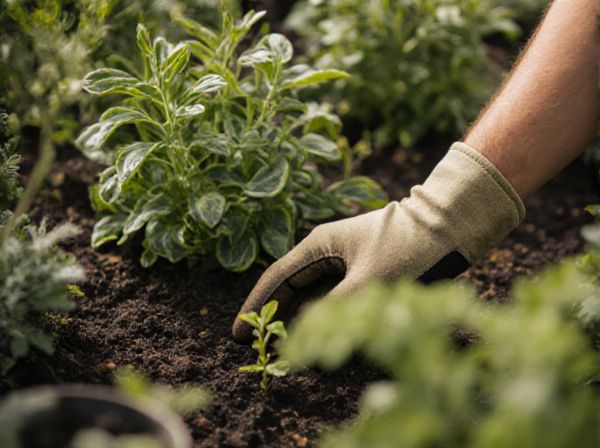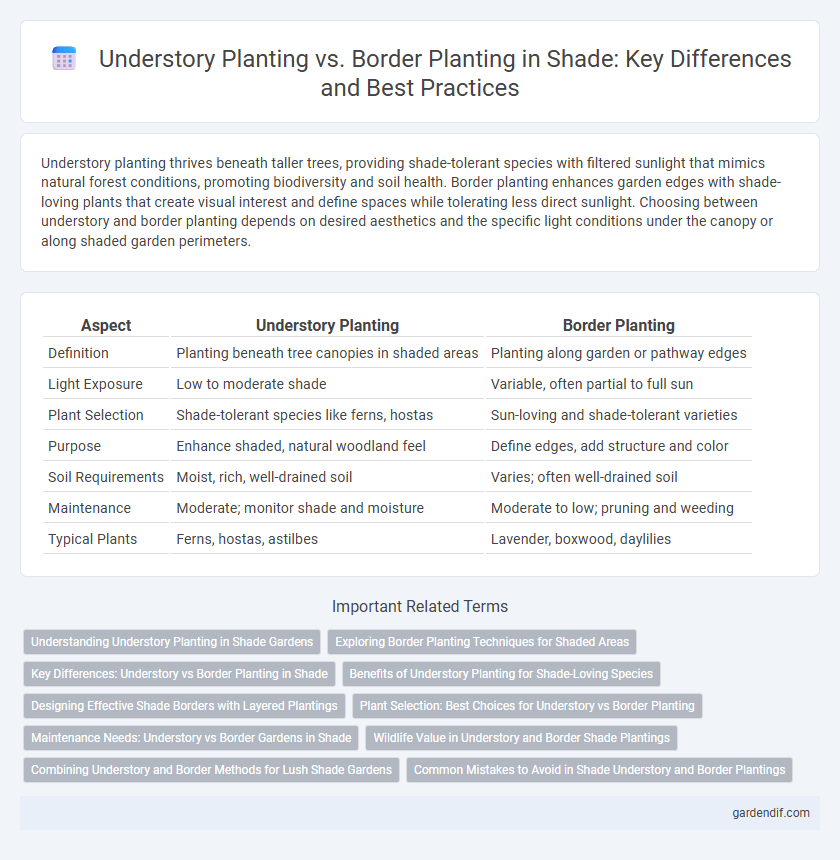
Understory Planting vs Border Planting Illustration
Understory planting thrives beneath taller trees, providing shade-tolerant species with filtered sunlight that mimics natural forest conditions, promoting biodiversity and soil health. Border planting enhances garden edges with shade-loving plants that create visual interest and define spaces while tolerating less direct sunlight. Choosing between understory and border planting depends on desired aesthetics and the specific light conditions under the canopy or along shaded garden perimeters.
Table of Comparison
| Aspect | Understory Planting | Border Planting |
|---|---|---|
| Definition | Planting beneath tree canopies in shaded areas | Planting along garden or pathway edges |
| Light Exposure | Low to moderate shade | Variable, often partial to full sun |
| Plant Selection | Shade-tolerant species like ferns, hostas | Sun-loving and shade-tolerant varieties |
| Purpose | Enhance shaded, natural woodland feel | Define edges, add structure and color |
| Soil Requirements | Moist, rich, well-drained soil | Varies; often well-drained soil |
| Maintenance | Moderate; monitor shade and moisture | Moderate to low; pruning and weeding |
| Typical Plants | Ferns, hostas, astilbes | Lavender, boxwood, daylilies |
Understanding Understory Planting in Shade Gardens
Understory planting in shade gardens involves cultivating plants beneath the canopy layer, capitalizing on the filtered light that penetrates the upper foliage. This method enhances biodiversity by selecting shade-tolerant species such as ferns, hostas, and woodland wildflowers that thrive in low-light conditions. Understanding the microclimate created by tree canopies is essential for successful understory planting, promoting soil moisture retention and creating a natural layered garden effect.
Exploring Border Planting Techniques for Shaded Areas
Border planting in shaded areas enhances garden depth by using shade-tolerant species like hostas, ferns, and astilbes that thrive in low light and improve soil moisture retention. Employing layered plant arrangements with varied heights and textures creates visual interest while maximizing space and airflow, which reduces fungal risks common in shaded environments. Incorporating mulch and organic matter enriches soil fertility and supports healthy root development, essential for sustaining lush understory growth along shaded borders.
Key Differences: Understory vs Border Planting in Shade
Understory planting in shade involves selecting shade-tolerant species that thrive beneath the canopy, such as ferns and hostas, which adapt to low light and high moisture conditions. Border planting in shaded areas focuses on edge species like astilbes and heucheras, which tolerate partial shade and create visual definition along pathways or garden edges. The key difference lies in their ecological niches: understory plants form a layered habitat under trees, while border plants emphasize ornamental structure and transitional zones in shaded landscapes.
Benefits of Understory Planting for Shade-Loving Species
Understory planting creates a natural microenvironment ideal for shade-loving species by providing filtered light and moisture retention, which enhances plant health and growth. It supports biodiversity by mimicking forest ecosystems, offering habitat for pollinators and beneficial insects while reducing soil erosion. This approach optimizes space under larger trees, improving garden aesthetics and ecological balance.
Designing Effective Shade Borders with Layered Plantings
Designing effective shade borders involves layering understory planting with taller border plants to create depth and maximize light utilization. Understory plants thrive in lower light conditions beneath tree canopies, while border planting includes medium-height shrubs and perennials that transition from shade to light zones. This layered approach enhances biodiversity, supports microclimates, and adds visual interest to shaded garden areas.
Plant Selection: Best Choices for Understory vs Border Planting
Understory planting thrives with shade-tolerant species like ferns, hostas, and wild ginger that adapt to low light and soil moisture conditions beneath trees. Border planting benefits from sun-loving perennials such as lavender, echinacea, and ornamental grasses that create vibrant edges with higher light exposure. Selecting plants based on sunlight requirements and growth habits ensures sustainable health and aesthetic appeal in both understory and border zones.
Maintenance Needs: Understory vs Border Gardens in Shade
Understory planting in shade requires careful monitoring of soil moisture and periodic pruning to prevent overcrowding, as these plants thrive beneath the canopy with limited sunlight. Border planting demands more frequent weeding and trimming to maintain clear pathways and defined edges, often involving species adapted to partial shade but with higher growth variability. Both planting styles benefit from mulching to conserve moisture and suppress weeds, but understory gardens typically involve less intensive maintenance due to more stable microclimate conditions.
Wildlife Value in Understory and Border Shade Plantings
Understory planting in shade environments provides critical habitat and food sources for diverse wildlife, supporting bird nesting, insect pollinators, and small mammals due to dense, layered vegetation. Border planting, while offering structural diversity and edge habitats, often supports fewer species because of its exposed nature and limited cover. Enhancing understory shade plantings with native shrubs and groundcovers significantly boosts biodiversity by creating protected, resource-rich microhabitats essential for many forest-dependent species.
Combining Understory and Border Methods for Lush Shade Gardens
Combining understory planting and border planting enhances shade garden vitality by layering diverse plant heights and textures, optimizing light utilization beneath tree canopies. Understory plants like ferns and hostas thrive in deep shade, while border plants such as astilbes and heucheras add color and structure at garden edges. This integrated approach creates a dynamic, lush shade environment that supports biodiversity and visual interest year-round.
Common Mistakes to Avoid in Shade Understory and Border Plantings
Common mistakes to avoid in shade understory planting include overcrowding plants that require more light, leading to poor growth and disease susceptibility. In border planting, neglecting soil moisture levels and selecting sun-loving plants can cause wilting and inadequate ground cover. Ensuring appropriate plant selection and spacing is crucial to thriving shade gardens.
Understory Planting vs Border Planting Infographic

 gardendif.com
gardendif.com